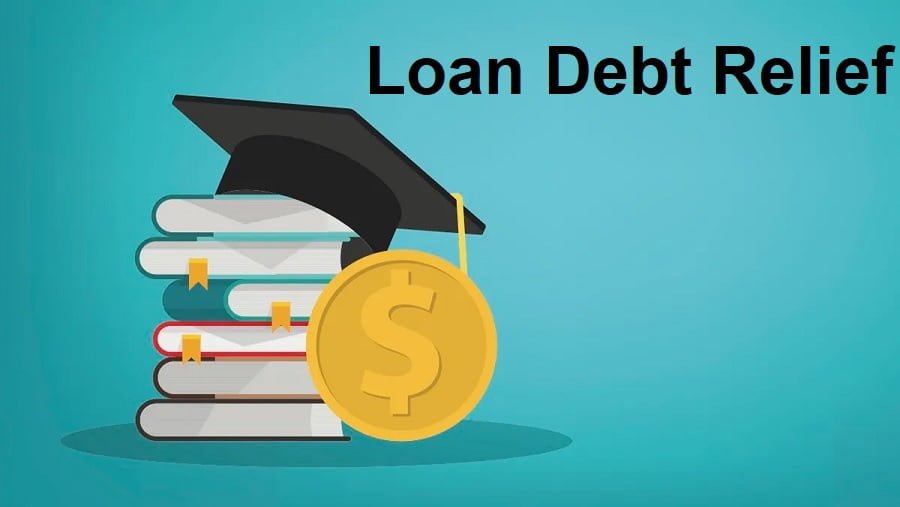Loan Debt Relief 2023 (Finding Relief from Overwhelming Loan Debt)

Introduction:
loan debt relief: With the rising costs of living, education, housing, and healthcare, more Americans are finding themselves buried under high-interest loan debt that feels impossible to pay off. Unpaid balances continue accumulating fees and interest, snowballing out of control. The constant stress takes a major toll both psychologically and physically.
However, there are options for finding relief from overwhelming loan debt. Debt relief programs provide a pathway to paying off loans in a manageable way and eventually rebuilding your financial life. This in-depth article will explore the different options for relieving and eliminating different types of unmanageable loan debt in 2023.
The Causes and Effects of Overwhelming Loan Debt:
Many interconnected factors have led to more households taking on loan debt they cannot reasonably pay off:
- Rising tuition costs have saddled younger generations with massive student loan debt, delaying major life steps like buying a house, getting married, and having children. Total U.S. student loan debt now exceeds $1.75 trillion.
- Unexpected healthcare costs from accidents, illnesses, and chronic conditions push many families to take out personal loans or max out credit cards to cover treatment and medications. Even with insurance, high deductibles and co-pays become debt.
- Stagnant wages failing to keep up with inflation have led to more households relying on credit cards and loans just to afford necessities each month. Any emergency expense or loss of income quickly becomes unpayable debt.
- Prolonged periods of unemployment or reduced work hours from economic downturns or layoffs decrease families’ ability to keep up with loan payments. The COVID-19 pandemic caused many to accumulate substantial loan debt just to stay afloat.
- Predatory lending practices entice borrowers with “easy approval” only to charge exorbitant interest rates and fees, trapping people in debt. Deceptive credit card offers also promote accumulating excessive balances.
- Lack of financial education leaves many Americans unprepared for wisely using credit and unaware of the snowball effect of compound interest on loans. Missed or late payments incur even more fees and penalties.
This vicious debt cycle leaves borrowers struggling each month just to keep up with minimum payments while the overall balance continues to rise. Even making payments on time every month provides little relief. The constant stress of debt takes a major toll on mental and physical health, sometimes leading to anxiety, depression, and chronic illness.
Overwhelming loan debt also limits consumers’ purchasing power, preventing economic recovery and growth. Until freed from the burden of unpayable high-interest debt, borrowers have little discretionary income to spend in ways that stimulate the broader economy.
Steps to Assess the Extent of Your Debt:
To determine the best path forward, the first vital step is to assess and document the full extent of your outstanding loan debt:
- Make a detailed list of all student loans (federal and private) along with the principal amount still owed on each and their respective interest rates. Also, note any federal loan forgiveness you may already qualify for.
- List all personal loans and their original purpose, amounts owed, interest rates, and minimum payments. Personal loans can be taken out from banks, credit unions, online lenders, friends/family, retirement accounts, etc.
- Detail all credit cards, store cards, and lines of credit, again noting balances owed, interest rates, minimum payments, credit limits, and if they are close to maxing out.
- Document any medical debt, payday loans, home equity loans, auto loans, or debts in collections along with relevant details on each.
- Add up the total principal amount owed across all current loans and debts. Separately calculate the total amount of interest paid each month across all minimum payments.
This information will provide a clear snapshot of just how overwhelming the debt burden has become. Tracking monthly payments made toward principal vs. interest will also show whether balances are decreasing each month or continuing to accumulate.
Confronting the Reality of Overwhelming Debt:
The natural tendency when faced with overwhelming debt is to avoid thinking about it entirely or downplay its severity. However, honestly facing the hard financial realities is essential for turning the situation around. Denial only allows the problem to persist and grow worse.
If the total interest paid each month exceeds the principal reduction, the debt load is unsustainable. Similarly, if monthly loan payments consume 30% or more of reliable monthly take-home income, it is unlikely that continuing the status quo will provide any meaningful relief.
The debt-to-income ratio indicates how much disposable income remains each month after making debt payments. A high ratio means few options for covering emergency costs or essential discretionary expenses to maintain a decent standard of living.
This honest assessment makes clear whether the current debt trajectory is realistic and opens the mind to consider paths forward other than more months or years of fruitless payment plans. The psychological readiness for change is a pivotal first step.
Potential Debt Relief Options to Regain Financial Health:
If objectively assessing your full debt picture shows payments are not reducing principal balances, it’s time to seriously consider supplemental or alternative debt relief options. While not easy paths, they can pay off balances faster, reduce or eliminate accumulating interest, and eventually free borrowers from the burden of overwhelming loan debt.
Credit Counseling Debt Management Programs
Non-profit credit counseling services offer debt management plans that work to consolidate payments and secure reduced interest rates and waived fees from lenders. By negotiating lower rates and more affordable payment terms, monthly costs decrease and more actually goes to reducing principal rather than interest. The extended repayment period depends on the amount owed.
Credit counseling services charge a small monthly fee for administering debt management plans but allow participants to pay off debt much faster and at a lower overall cost. They provide budgeting guidance, educational resources, and ongoing support. Plans are flexible for changing circumstances.
Debt Consolidation Loans
Debt consolidation combines multiple high-interest debts like credit cards and personal loans into one new consolidated loan with a fixed interest rate and term length. This reduces chaotic monthly payments into one predictable payment.
Borrowers must have sufficiently high credit to qualify for these loans. Lower credit scores get higher interest rates, reducing potential savings. Debt consolidation works best for those able to secure a significantly lower interest rate than current debts. The goal is to lower the total interest paid over the full repayment period.
Debt Settlement
For severely overwhelming unsecured debt, debt settlement provides a way to resolve balances owed at a discount, usually 40 to 60% of the total. A debt settlement company negotiates directly with credit card companies and other lenders to agree on a reduced “settlement” amount as full payment.
The borrower makes fixed monthly payments to a special escrow account. Once sufficient funds accumulate, the settlement deals are made. This does damage credit substantially but allows debt to eventually be resolved at a fraction of its face value. Any forgiven debt may be taxable income.
Bankruptcy
As a last resort when debt payments are truly unmanageable, personal bankruptcy filings erase most eligible debt. However, bankruptcy damages credit for 7-10 years and has other long-term financial consequences. The specific debts discharged depend on the chapter of bankruptcy protection pursued.
Still, for those facing home foreclosure, asset seizure, or who simply cannot keep up with even minimum payments, bankruptcy may be the only option. Medical bankruptcies have also increased with skyrocketing healthcare costs. The discharge provides complete debt relief and a chance to rebuild finances.
Government Student Loan Forgiveness Programs
For those with mostly federal and other student loan debt, government forgiveness and discharge programs provide options besides standard repayment. These include:
- Income-driven repayment plans base monthly payments on disposable income, extending repayment periods to 20-25 years. Any loan balance remaining after payments made over this period is forgiven.
- Public Service Loan Forgiveness fully discharges remaining federal student loan debt after making 120 qualifying payments while employed in public service such as government agencies and 501(c)(3) non-profits.
- Teacher Loan Forgiveness programs offer up to $17,500 in loan forgiveness for federal loans to qualified teachers after 5 consecutive years of service in low-income schools and educational service agencies.
- Borrower defense to repayment discharge forgives federal student loans taken out to attend schools engaged in illegal or deceptive practices. Wide-scale discharges have been approved for loans associated with predatory for-profit colleges.
- Total permanent disability discharge forgives eligible federal student loans for borrowers with permanently disabling health conditions.
- Closed school discharge forgives federal loans for students unable to complete degrees due to school closure.
Comparing Debt Relief Programs and Criteria:
Choosing the best debt relief option depends entirely on your specific situation – the types and sources of debt owed, monthly income versus payments, credit score impacts, and eligibility for government programs.
Those with mostly credit card debt can likely benefit most from credit counseling management plans and debt consolidation loans. Good credit scores allow lower interest rate consolidation loans.
For recent graduates or those only holding student loans, aim for government forgiveness programs. Research eligibility for existing or new income-driven repayment plans. Those working in public service should commit to meeting requirements for Public Service Loan Forgiveness.
If debts are truly unmanageable with no chance to pay even minimums, debt settlement or bankruptcy become options. Weigh the consequences of both carefully relative to the severity of your situation.
The key is being honest with yourself in assessing total debts owed, documenting a complete picture of obligations, and monthly resources, and then pursuing the relief option most matched to your circumstances.
Committing to the Path Forward:
Choosing an appropriate debt relief strategy empowers borrowers to take control of their finances after feeling buried by overwhelming loan debt. But the path forward also requires discipline and commitment.
Work diligently to complete all steps required for the debt relief program pursued, including accurately documenting debt, making required monthly payments, maintaining eligibility, and following up persistently with lenders and service agencies.
Stay organized with all related paperwork and keep records of payment history, eligibility status, and lender correspondence. Keep lines of communication open and escalate issues when needed to ensure staying on track.
Consistency and diligence will help ensure you receive full benefits from the debt relief option chosen and maintain progress toward the goal of paying off debt faster, reducing interest paid, and eventually becoming free from the burden of overwhelming loan balances



